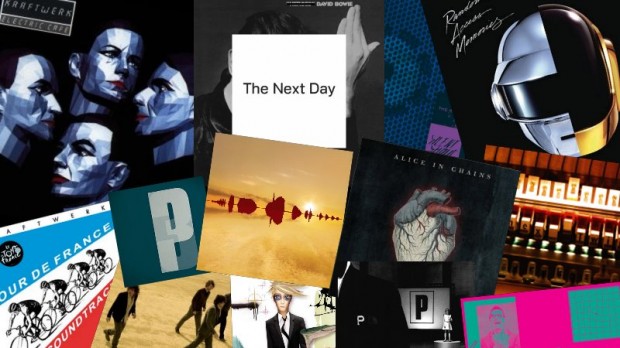
This month, London’s sonic experimentalists PINK FLOYD will be releasing their first studio album in two decades, The Endless River. This September, hyper intense electronic musician APHEX TWIN released Syro after 13 years and a mysterious blimp that appeared both in London and New York.
We at NOTHING BUT HOPE AND PASSION wondered if a once successful artist would still have the ability to create something commercially and aurally relevant after such a long pause? There have been many attempts, ranging from amazing to Chinese Democracy. And there are far too many ones to mention them all. From spectacular gaps of 28 years (THE EAGLES), 34 years (THE STOOGES) or even 36 years (YARDBIRDS) – the stakes a high, especially with some old big players. We decided to focus on some of the more recent release gaps as we take a look at 9 artistes, and survey what they did right (or wrong) from what they have left behind.
The Knife – 7 Years
Silent Shout (2006) to Shaking The Habitual (2013)
From their legendary great record (Silent Shout) to their boundary challenging fourth album (Shaking The Habitual), Swedish duo THE KNIFE ditched all form of mythological mystery that they have built up. Shaking The Habitual reminds listeners of the real issues – prosperity, monarchy, and patriarchy – in one massive 97-minute record.
Daft Punk – 8 Years
Human After All (2005) to Random Access Memories (2013)
Electronic music savants Guy-Manuel de Homem-Christo and Thomas Bangalter have always managed to build up emotions akin to sexual frustration with minimal output to maximum hype. After collaborating with Chic’s Nile Rodgers and resurrecting Pharrell Williams from the dead, DAFT PUNK’s revitalized disco sound in Random Access Memories certainly sound fuller and warmer than their previous three offerings (not counting the soundtrack for Tron:Legacy), with the unique vocoder remaining a classic staple.
David Bowie – 10 Years
Reality (2003) to The Next Day (2013)
Surprising critics and fans alike after a decade of silence by releasing Where Are We Now? on his 66th birthday in 2013, BOWIE’s twenty-fourth studio album seems like an autobiography of sorts, questioning morality and defying assumptions that he had retired. Dense, angry and complicated, The Next Day juxtaposes the happy and carefree vibe of Reality.
Take That – 11 Years
Nobody Else (1995) to Beautiful World (2006)
With mellow references to classic rock (Strawberry Fields Forever in Patience) and tacky but effective COLDPLAY-esque damper pads and falsettos, Beautiful World is a charm amongst ardent fans of somber Brit-boyband-pop as compared to the kitsch karaoke backdrops that accompany previous album Nobody Else.
Portishead – 11 Years
Portishead (1997) to Third (2008)
PORTISHEAD’s signature precision when it comes to detailed sound design becomes more obvious on Third. Aggressive and abrasive dissonance coupled Beth Gibbons’ haunting vocals seems to be a winning formula for a re-brand, transiting into psychedelic rock from smooth alternative rock. It’s like your friendly neighbourhood restaurant revamping the menu, only to have your favourite dish made spicier than before.
Kate Bush – 12 Years
The Red Shoes (1993) to Aerial (2005)
With music critics slapping a ‘mediocre’ label on BUSH’s 1993 effort and deeming Aerial a domesticated failure, it was a huge surprise when tickets to her 2014 comeback residency in London’s Hammersmith Apollo sold out within 15 minutes. Apparently her theatrical performances were brilliant, making up for disappointing recordings.
Aphex Twin – 13 Years
Drukqs (2001) to Syro (2014)
When Drukqs was first released, few would have thought that it would pave the way for musical experimentation in the years that followed. A double album chock full with apoplectic cadences and contrasting soundscapes, it made Richard D James a household name and not some ginger kid from Cornwall. Syro contains 65 minutes of precise and highly melodic electronics, which could possibly come from no other musician.
Alice in Chains – 14 Years
Alice in Chains (1995) to Black Gives Way to Blue (2009)
Many of music’s finest have succumbed to drug addiction – footwork pioneer DJ Rashad, Amy Winehouse, and Jimi Hendrix, to name a few. In the case of ALICE IN CHAINS, both lead singer (Layne Staley) and bassist (Mike Starr) joined the ranks, and it did not cross anyone’s mind that ALICE IN CHAINS would reform, and if they did, would they still match up? After their grunge success in the Nineties that was the soundtrack to Staley’s drug addiction, their 2009 record (with new vocalist William DuVall) seems to be like a public service announcement for drug addiction.
[youtube id=”lr_tyst3SVE” width=”620″ height=”335″]
Kraftwerk – 17 Years
Electric Café (1986) to Tour de France Soundtracks (2003)
Arguably not their best work, and definitely not an original soundtrack album, Tour de France was a crooked nod to KRAFTWERK’s legacy in laying the foundations for electronic music. From sampling to influencing artiste image, it was slightly disappointing that their ‘comeback’ album was slipshod – but if you take a step back, it still manages to retain some sort of artificial charm.
—